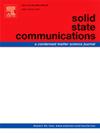Modification of Majorana leakage effect due to the presence of quantum interference
IF 2.1
4区 物理与天体物理
Q3 PHYSICS, CONDENSED MATTER
引用次数: 0
Abstract
This study delves into the Majorana leakage effect modified by the quantum interference, by coupling one Majorana zero mode (MZM) simultaneously to two dots in a double-quantum-dot Aharonov-Bohm interferometer device. Our findings reveal that the Majorana leakage effect significantly diverges from the single-dot case, predominantly influenced by the symmetry properties of the arms of the interferometer. Remarkably, with identical arms, the Majorana leakage effect halves the low-bias conductance magnitude for magnetic flux phase factor (). In contrast, when inter-arm symmetry is disrupted, this halving phenomenon is restricted to instances where , accompanied by a -periodic variation in low-bias conductances. Consequently, the Majorana leakage effect is intricately tied to the quantum interference patterns, offering insights into the quantum coherence and transport in hybrid superconducting systems.
量子干扰存在时对马约拉纳泄漏效应的修正
本研究通过将一个马约拉纳零模(MZM)同时耦合到双量子点阿哈诺夫-玻姆干涉仪装置中的两个点,深入研究了量子干涉修饰的马约拉纳泄漏效应。我们的研究结果表明,马约拉纳泄漏效应与单点情况大相径庭,主要受到干涉仪臂对称性的影响。值得注意的是,在臂完全相同的情况下,当磁通量相位因子ϕ≠2nπ(n∈Integer)时,马约拉纳漏磁效应会使低偏导幅度减半。与此相反,当臂间对称性被破坏时,这种减半现象仅限于 ϕ=2nπ 的情况,并伴随着低偏导的 4π 周期性变化。因此,马约拉纳漏电效应与量子干涉模式密切相关,为了解混合超导系统中的量子相干性和传输提供了启示。
本文章由计算机程序翻译,如有差异,请以英文原文为准。
求助全文
约1分钟内获得全文
求助全文
来源期刊

Solid State Communications
物理-物理:凝聚态物理
CiteScore
3.40
自引率
4.80%
发文量
287
审稿时长
51 days
期刊介绍:
Solid State Communications is an international medium for the publication of short communications and original research articles on significant developments in condensed matter science, giving scientists immediate access to important, recently completed work. The journal publishes original experimental and theoretical research on the physical and chemical properties of solids and other condensed systems and also on their preparation. The submission of manuscripts reporting research on the basic physics of materials science and devices, as well as of state-of-the-art microstructures and nanostructures, is encouraged.
A coherent quantitative treatment emphasizing new physics is expected rather than a simple accumulation of experimental data. Consistent with these aims, the short communications should be kept concise and short, usually not longer than six printed pages. The number of figures and tables should also be kept to a minimum. Solid State Communications now also welcomes original research articles without length restrictions.
The Fast-Track section of Solid State Communications is the venue for very rapid publication of short communications on significant developments in condensed matter science. The goal is to offer the broad condensed matter community quick and immediate access to publish recently completed papers in research areas that are rapidly evolving and in which there are developments with great potential impact.
 求助内容:
求助内容: 应助结果提醒方式:
应助结果提醒方式:


